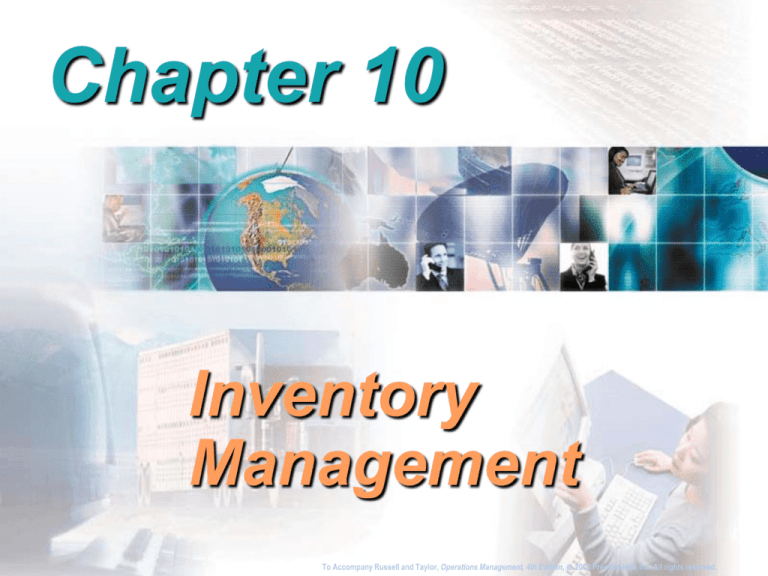
Chapter 10
Inventory
Management
To Accompany Russell and Taylor, Operations Management, 4th Edition, 2003 Prentice-Hall, Inc. All rights reserved.
To Accompany Russell and Taylor, Operations Management, 4th Edition, 2003 Prentice-Hall, Inc. All rights reserved.
Inventory
Stock of items held to meet
future demand
Inventory management answers
two questions
How much to order
When to order
To Accompany Russell and Taylor, Operations Management, 4th Edition, 2003 Prentice-Hall, Inc. All rights reserved.
Types of Inventory
Raw materials
Purchased parts and supplies
Labor
In-process (partially completed) products
Component parts
Working capital
Tools, machinery, and equipment
To Accompany Russell and Taylor, Operations Management, 4th Edition, 2003 Prentice-Hall, Inc. All rights reserved.
Reasons to Hold
Inventory
Meet unexpected demand
Smooth seasonal or cyclical demand
Meet variations in customer demand
Take advantage of
price discounts
Hedge against price
increases
Quantity discounts
To Accompany Russell and Taylor, Operations Management, 4th Edition, 2003 Prentice-Hall, Inc. All rights reserved.
Two Forms of Demand
Dependent
Items used to produce final products
Independent
Items demanded by external customers
To Accompany Russell and Taylor, Operations Management, 4th Edition, 2003 Prentice-Hall, Inc. All rights reserved.
Inventory Costs
Carrying Cost
Cost of holding an item in inventory
Ordering Cost
Cost of replenishing inventory
Shortage Cost
Temporary or permanent loss of
sales when demand cannot be met
To Accompany Russell and Taylor, Operations Management, 4th Edition, 2003 Prentice-Hall, Inc. All rights reserved.
Inventory Control
Systems
Continuous system (fixed-orderquantity)
Constant amount ordered when
inventory declines to predetermined
level
Periodic system (fixed-time-period)
Order placed for variable amount
after fixed passage of time
To Accompany Russell and Taylor, Operations Management, 4th Edition, 2003 Prentice-Hall, Inc. All rights reserved.
ABC Classification
System
Demand volume and value of items vary
Classify inventory into 3 categories,
typically on the basis of the dollar value
to the firm
CLASS
A
B
C
PERCENTAGE
OF UNITS
5 - 15
30
50 - 60
PERCENTAGE
OF DOLLARS
70 - 80
15
5 - 10
To Accompany Russell and Taylor, Operations Management, 4th Edition, 2003 Prentice-Hall, Inc. All rights reserved.
ABC Classification
PART
1
2
3
4
5
6
7
8
9
10
UNIT COST
ANNUAL USAGE
$ 60
350
30
80
30
20
10
320
510
20
90
40
130
60
100
180
170
50
60
120
Example 10.1
To Accompany Russell and Taylor, Operations Management, 4th Edition, 2003 Prentice-Hall, Inc. All rights reserved.
ABC Classification
PART
9
8
2
1
4
3
6
5
10
7
TOTAL
PART
VALUE
$30,600
1
16,000
2
14,000
3
5,400
4
4,800
5
3,900
3,600
6
3,000
7
2,400
8
1,700
9
$85,400
10
% OF TOTAL % OF TOTAL
UNIT
ANNUAL
USAGE
VALUECOSTQUANTITY
% CUMMULATIVE
35.9
$ 60
18.7
350
16.4
30
6.3
5.680
4.630
4.220
3.510
2.8
320
2.0
510
20
6.0
5.0
4.0
9.0
6.0
10.0
18.0
13.0
12.0
17.0
90
40
130
60
100
180
170
50
60
120
6.0
11.0
15.0
24.0
30.0
40.0
58.0
71.0
83.0
100.0
Example 10.1
To Accompany Russell and Taylor, Operations Management, 4th Edition, 2003 Prentice-Hall, Inc. All rights reserved.
ABC Classification
PART
9
8
2
1
4
3
6
5
10
7
TOTAL
PART
VALUE
$30,600
1
16,000
2
14,000
3
5,400
4
4,800
5
3,900
3,600
6
3,000
7
2,400
8
1,700
9
$85,400
10
% OF TOTAL % OF TOTAL
UNIT
ANNUAL
USAGE
VALUECOSTQUANTITY
% CUMMULATIVE
35.9
$ 60
18.7
350
16.4
30
6.3
5.680
4.630
4.220
3.510
2.8
320
2.0
510
20
6.0
5.0
4.0
9.0
6.0
10.0
18.0
13.0
12.0
17.0
90
A
40
130
60
B
100
180
170
C
50
60
120
6.0
11.0
15.0
24.0
30.0
40.0
58.0
71.0
83.0
100.0
Example 10.1
To Accompany Russell and Taylor, Operations Management, 4th Edition, 2003 Prentice-Hall, Inc. All rights reserved.
ABC Classification
PART
TOTAL
PART
VALUE
9 $30,600
1
8
16,000
2
2
14,000
3
1 CLASS
5,400
4
4
4,800
A3,900
5
3
B3,600
6
6
C3,000
5
7
10
2,400
8
7
1,700
9
$85,400
10
% OF TOTAL % OF TOTAL
UNIT
ANNUAL
USAGE
VALUECOSTQUANTITY
% CUMMULATIVE
35.9
6.0
$ 60
18.7
5.0
350
16.4 % OF TOTAL
4.0
30
ITEMS6.3
VALUE9.0
5.680
6.0
9, 8, 2 4.630
71.010.0
1, 4, 3 4.220
16.518.0
6, 5, 10,
12.513.0
3.5710
2.8
12.0
320
2.0
17.0
510
20
6.0
90
11.0
A
40
15.0
% OF TOTAL
130
24.0
QUANTITY
60
B 15.030.0
100
40.0
180 25.058.0
60.071.0
170
C
83.0
50
100.0
60
120
Example 10.1
To Accompany Russell and Taylor, Operations Management, 4th Edition, 2003 Prentice-Hall, Inc. All rights reserved.
ABC Classification
C
100 –
B
% of Value
80 –
60 –
A
40 –
20 –
0 |–
0
|
20
|
40
|
60
|
80
|
100
% of Quantity
To Accompany Russell and Taylor, Operations Management, 4th Edition, 2003 Prentice-Hall, Inc. All rights reserved.
Assumptions of Basic
EOQ Model
Demand is known with certainty
and is constant over time
No shortages are allowed
Lead time for the receipt of orders
is constant
The order quantity is received all
at once
To Accompany Russell and Taylor, Operations Management, 4th Edition, 2003 Prentice-Hall, Inc. All rights reserved.
The Inventory Order Cycle
Inventory Level
Order quantity, Q
Reorder point, R
0
Time
Figure 10.1
To Accompany Russell and Taylor, Operations Management, 4th Edition, 2003 Prentice-Hall, Inc. All rights reserved.
The Inventory Order Cycle
Order quantity, Q
Inventory Level
Demand
rate
Reorder point, R
0
Figure 10.1
Lead
time
Order Order
placed receipt
Lead
time
Order Order
placed receipt
Time
To Accompany Russell and Taylor, Operations Management, 4th Edition, 2003 Prentice-Hall, Inc. All rights reserved.
EOQ Cost Model
Co - cost of placing order
Cc - annual per-unit carrying cost
D - annual demand
Q - order quantity
Co D
Annual ordering cost =
Q
CcQ
Annual carrying cost =
2
CoD
CcQ
Total cost =
+
Q
2
To Accompany Russell and Taylor, Operations Management, 4th Edition, 2003 Prentice-Hall, Inc. All rights reserved.
EOQ Cost Model
CDeriving
D - annual
demand
o - cost ofQplacing order
Proving
equality
of
opt
at optimal
point
Cc - annual per-unit carrying cost costs
Q - order
quantity
CoD
CcQ
TC =
+
Q
2
CoD
CcQ
Annual ordering cost =
=
Q
2
C
D
C
TC
o
c
=
+
Q2
2
Q
CcQ
2CoD
Annual carrying cost = Q2 =
2
C0D
Cc
Cc
0=
+
Q2
2
CoD
CcQ
2CoD
Total cost =
+
Q
2Q =
2CoD
opt
Cc
Qopt =
Cc
To Accompany Russell and Taylor, Operations Management, 4th Edition, 2003 Prentice-Hall, Inc. All rights reserved.
EOQ Cost Model
Annual
cost ($)
Order Quantity, Q
Figure 10.2
To Accompany Russell and Taylor, Operations Management, 4th Edition, 2003 Prentice-Hall, Inc. All rights reserved.
EOQ Cost Model
Annual
cost ($)
CoD
Ordering Cost = Q
Order Quantity, Q
Figure 10.2
To Accompany Russell and Taylor, Operations Management, 4th Edition, 2003 Prentice-Hall, Inc. All rights reserved.
EOQ Cost Model
Annual
cost ($)
CcQ
Carrying Cost =
2
CoD
Ordering Cost = Q
Order Quantity, Q
Figure 10.2
To Accompany Russell and Taylor, Operations Management, 4th Edition, 2003 Prentice-Hall, Inc. All rights reserved.
EOQ Cost Model
Annual
cost ($)
Total Cost
Slope = 0
CcQ
Carrying Cost =
2
Minimum
total cost
CoD
Ordering Cost = Q
Optimal order
Qopt
Order Quantity, Q
Figure 10.2
To Accompany Russell and Taylor, Operations Management, 4th Edition, 2003 Prentice-Hall, Inc. All rights reserved.
EOQ Example
Cc = $0.75 per yard
Qopt =
2CoD
Cc
Qopt =
2(150)(10,000)
(0.75)
Qopt = 2,000 yards
Co = $150
D = 10,000 yards
CoD
CcQ
TCmin =
+
Q
2
TCmin
(150)(10,000) (0.75)(2,000)
=
+
2,000
2
TCmin = $750 + $750 = $1,500
Orders per year = D/Qopt
Order cycle time = 311 days/(D/Qopt)
= 10,000/2,000
= 311/5
= 5 orders/year
= 62.2 store days
Example 10.2
To Accompany Russell and Taylor, Operations Management, 4th Edition, 2003 Prentice-Hall, Inc. All rights reserved.
EOQ with
Noninstantaneous Receipt
Inventory
level
Q(1-d/p)
Maximum
inventory
level
Q
(1-d/p)
2
Average
inventory
level
0
Time
Figure 10.3
To Accompany Russell and Taylor, Operations Management, 4th Edition, 2003 Prentice-Hall, Inc. All rights reserved.
EOQ with
Noninstantaneous Receipt
Inventory
level
Q(1-d/p)
Maximum
inventory
level
Q
(1-d/p)
2
Average
inventory
level
0
Order
receipt period
Begin End
order order
receipt receipt
Time
Figure 10.3
To Accompany Russell and Taylor, Operations Management, 4th Edition, 2003 Prentice-Hall, Inc. All rights reserved.
EOQ with
Noninstantaneous Receipt
p = production rate
d = demand rate
Maximum inventory level = Q - Q d
p
=Q1- d
p
Q
d
Average inventory level =
12
p
2CoD
Qopt =
d
Cc 1 p
CoD CcQ
d
TC = Q + 2 1 - p
To Accompany Russell and Taylor, Operations Management, 4th Edition, 2003 Prentice-Hall, Inc. All rights reserved.
Production Quantity
Cc = $0.75 per yard
Co = $150
d = 10,000/311 = 32.2 yards per day
2CoD
Qopt =
Cc 1 - d
p
D = 10,000 yards
p = 150 yards per day
2(150)(10,000)
=
CoD CcQ
d
TC = Q + 2 1 - p
32.2
0.75 1 150
= 2,256.8 yards
= $1,329
2,256.8
Q
Production run =
=
= 15.05 days per order
150
p
Example 10.3
To Accompany Russell and Taylor, Operations Management, 4th Edition, 2003 Prentice-Hall, Inc. All rights reserved.
Production Quantity
Cc = $0.75 per yard
Co = $150
d = 10,000/311 = 32.2 yards per day
D = 10,000 yards
p = 150 yards per day
2CoD
2(150)(10,000)
10,000 = 2,256.8 yards
D
Qopt =
=
d
32.2
Number of
production
runs
=
=
= 4.43 runs/year
Cc 1 0.75Q1 - 2,256.8
150
p
d
32.2
Maximum
inventory
level
=
Q
1
=
2,256.8
1
CoD CcQ
d
p
150
TC = Q + 2 1 - p = $1,329
= 1,772 yards
2,256.8
Q
Production run =
=
= 15.05 days per order
150
p
Example 10.3
To Accompany Russell and Taylor, Operations Management, 4th Edition, 2003 Prentice-Hall, Inc. All rights reserved.
Quantity Discounts
Price per unit decreases as order
quantity increases
CoD
CcQ
TC =
+
+ PD
Q
2
where
P = per unit price of the item
D = annual demand
To Accompany Russell and Taylor, Operations Management, 4th Edition, 2003 Prentice-Hall, Inc. All rights reserved.
Quantity Discounts
Price per unit decreases as order
quantity increases
CoD
CcQ
TC =
+
+ PD
Q
2
where
ORDER SIZE
P = per unit price
0 - of
99the item
D = annual
100demand
- 199
200+
PRICE
$10
8 (d1)
6 (d2)
To Accompany Russell and Taylor, Operations Management, 4th Edition, 2003 Prentice-Hall, Inc. All rights reserved.
Inventory cost ($)
Quantity Discount Model
Figure 10.4
To Accompany Russell and Taylor, Operations Management, 4th Edition, 2003 Prentice-Hall, Inc. All rights reserved.
Quantity Discount Model
TC = ($10 )
TC (d1 = $8 )
Inventory cost ($)
TC (d2 = $6 )
Carrying cost
Ordering cost
Q(d1 ) = 100 Qopt
Q(d2 ) = 200
Figure 10.4
To Accompany Russell and Taylor, Operations Management, 4th Edition, 2003 Prentice-Hall, Inc. All rights reserved.
Quantity Discount Model
TC = ($10 )
TC (d1 = $8 )
Inventory cost ($)
TC (d2 = $6 )
Carrying cost
Ordering cost
Q(d1 ) = 100 Qopt
Q(d2 ) = 200
Figure 10.4
To Accompany Russell and Taylor, Operations Management, 4th Edition, 2003 Prentice-Hall, Inc. All rights reserved.
Quantity Discount
QUANTITY
1 - 49
50 - 89
90+
Qopt =
PRICE
$1,400
1,100
900
2CoD
=
Cc
Co = $2,500
Cc = $190 per computer
D = 200
2(2500)(200)
= 72.5 PCs
190
For Q = 72.5
CcQopt
Co D
TC =
+
2 + PD = $233,784
Qopt
For Q = 90
CcQ
C oD
TC =
+ 2 + PD = $194,105
Q
Example 10.4
To Accompany Russell and Taylor, Operations Management, 4th Edition, 2003 Prentice-Hall, Inc. All rights reserved.
When to Order
Reorder Point is the level of inventory
at which a new order is placed
R = dL
where
d = demand rate per period
L = lead time
To Accompany Russell and Taylor, Operations Management, 4th Edition, 2003 Prentice-Hall, Inc. All rights reserved.
Reorder Point Example
Demand = 10,000 yards/year
Store open 311 days/year
Daily demand = 10,000 / 311 = 32.154 yards/day
Lead time = L = 10 days
R = dL = (32.154)(10) = 321.54 yards
Example 10.5
To Accompany Russell and Taylor, Operations Management, 4th Edition, 2003 Prentice-Hall, Inc. All rights reserved.
Safety Stocks
Safety stock
buffer added to on hand inventory during
lead time
Stockout
an inventory shortage
Service level
probability that the inventory available
during lead time will meet demand
To Accompany Russell and Taylor, Operations Management, 4th Edition, 2003 Prentice-Hall, Inc. All rights reserved.
Variable Demand with
a Reorder Point
Inventory level
Q
Reorder
point, R
0
Figure 10.5
Time
To Accompany Russell and Taylor, Operations Management, 4th Edition, 2003 Prentice-Hall, Inc. All rights reserved.
Variable Demand with
a Reorder Point
Inventory level
Q
Reorder
point, R
0
LT
Figure 10.5
LT
Time
To Accompany Russell and Taylor, Operations Management, 4th Edition, 2003 Prentice-Hall, Inc. All rights reserved.
Inventory level
Reorder Point with
a Safety Stock
Q
Reorder
point, R
Safety Stock
0
LT
Figure 10.6
LT
Time
To Accompany Russell and Taylor, Operations Management, 4th Edition, 2003 Prentice-Hall, Inc. All rights reserved.
Reorder Point With
Variable Demand
R = dL + zd L
where
d = average daily demand
L = lead time
d = the standard deviation of daily demand
z = number of standard deviations
corresponding to the service level
probability
zd L = safety stock
To Accompany Russell and Taylor, Operations Management, 4th Edition, 2003 Prentice-Hall, Inc. All rights reserved.
Reorder Point for
a Service Level
Probability of
meeting demand during
lead time = service level
Probability of
a stockout
Safety stock
zd L
Figure 10.7
dL
Demand
R
To Accompany Russell and Taylor, Operations Management, 4th Edition, 2003 Prentice-Hall, Inc. All rights reserved.
Reorder Point for
Variable Demand
The carpet store wants a reorder point with a
95% service level and a 5% stockout probability
d = 30 yards per day
L = 10 days
d = 5 yards per day
For a 95% service level, z = 1.65
R = dL + z d L
Safety stock = z d L
= 30(10) + (1.65)(5)( 10)
= (1.65)(5)( 10)
= 326.1 yards
= 26.1 yards
Example 10.6
To Accompany Russell and Taylor, Operations Management, 4th Edition, 2003 Prentice-Hall, Inc. All rights reserved.
Order Quantity for a
Periodic Inventory System
Q = d(tb + L) + zd
tb + L - I
where
d
tb
L
d
zd
= average demand rate
= the fixed time between orders
= lead time
= standard deviation of demand
tb + L = safety stock
I = inventory level
To Accompany Russell and Taylor, Operations Management, 4th Edition, 2003 Prentice-Hall, Inc. All rights reserved.
Fixed-Period Model with
Variable Demand
d
d
tb
L
I
z
= 6 bottles per day
= 1.2 bottles
= 60 days
= 5 days
= 8 bottles
= 1.65 (for a 95% service level)
Q = d(tb + L) + zd
tb + L - I
= (6)(60 + 5) + (1.65)(1.2)
60 + 5 - 8
= 397.96 bottles
To Accompany Russell and Taylor, Operations Management, 4th Edition, 2003 Prentice-Hall, Inc. All rights reserved.








